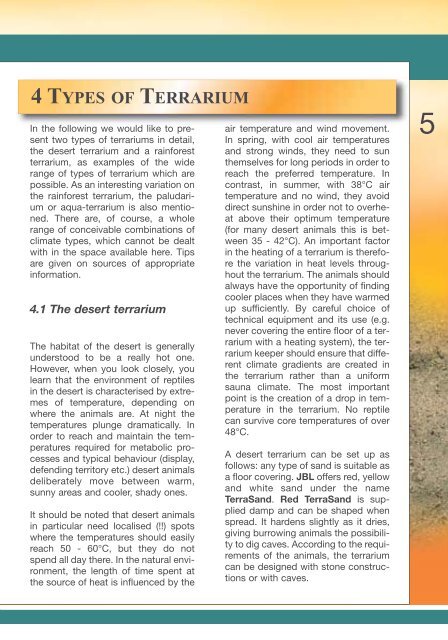How? Setting up a terrarium Useful tips for ... - Reptiles Greece
How? Setting up a terrarium Useful tips for ... - Reptiles Greece
How? Setting up a terrarium Useful tips for ... - Reptiles Greece
Create successful ePaper yourself
Turn your PDF publications into a flip-book with our unique Google optimized e-Paper software.
4 TYPES OF TERRARIUM<br />
In the following we would like to present<br />
two types of <strong>terrarium</strong>s in detail,<br />
the desert <strong>terrarium</strong> and a rain<strong>for</strong>est<br />
<strong>terrarium</strong>, as examples of the wide<br />
range of types of <strong>terrarium</strong> which are<br />
possible. As an interesting variation on<br />
the rain<strong>for</strong>est <strong>terrarium</strong>, the paludarium<br />
or aqua-<strong>terrarium</strong> is also mentioned.<br />
There are, of course, a whole<br />
range of conceivable combinations of<br />
climate types, which cannot be dealt<br />
with in the space available here. Tips<br />
are given on sources of appropriate<br />
in<strong>for</strong>mation.<br />
4.1 The desert <strong>terrarium</strong><br />
The habitat of the desert is generally<br />
understood to be a really hot one.<br />
<strong>How</strong>ever, when you look closely, you<br />
learn that the environment of reptiles<br />
in the desert is characterised by extremes<br />
of temperature, depending on<br />
where the animals are. At night the<br />
temperatures plunge dramatically. In<br />
order to reach and maintain the temperatures<br />
required <strong>for</strong> metabolic processes<br />
and typical behaviour (display,<br />
defending territory etc.) desert animals<br />
deliberately move between warm,<br />
sunny areas and cooler, shady ones.<br />
It should be noted that desert animals<br />
in particular need localised (!!) spots<br />
where the temperatures should easily<br />
reach 50 - 60°C, but they do not<br />
spend all day there. In the natural environment,<br />
the length of time spent at<br />
the source of heat is influenced by the<br />
air temperature and wind movement.<br />
In spring, with cool air temperatures<br />
and strong winds, they need to sun<br />
themselves <strong>for</strong> long periods in order to<br />
reach the preferred temperature. In<br />
contrast, in summer, with 38°C air<br />
temperature and no wind, they avoid<br />
direct sunshine in order not to overheat<br />
above their optimum temperature<br />
(<strong>for</strong> many desert animals this is between<br />
35 - 42°C). An important factor<br />
in the heating of a <strong>terrarium</strong> is there<strong>for</strong>e<br />
the variation in heat levels throughout<br />
the <strong>terrarium</strong>. The animals should<br />
always have the opportunity of finding<br />
cooler places when they have warmed<br />
<strong>up</strong> sufficiently. By careful choice of<br />
technical equipment and its use (e.g.<br />
never covering the entire floor of a <strong>terrarium</strong><br />
with a heating system), the <strong>terrarium</strong><br />
keeper should ensure that different<br />
climate gradients are created in<br />
the <strong>terrarium</strong> rather than a uni<strong>for</strong>m<br />
sauna climate. The most important<br />
point is the creation of a drop in temperature<br />
in the <strong>terrarium</strong>. No reptile<br />
can survive core temperatures of over<br />
48°C.<br />
A desert <strong>terrarium</strong> can be set <strong>up</strong> as<br />
follows: any type of sand is suitable as<br />
a floor covering. JBL offers red, yellow<br />
and white sand under the name<br />
TerraSand. Red TerraSand is s<strong>up</strong>plied<br />
damp and can be shaped when<br />
spread. It hardens slightly as it dries,<br />
giving burrowing animals the possibility<br />
to dig caves. According to the requirements<br />
of the animals, the <strong>terrarium</strong><br />
can be designed with stone constructions<br />
or with caves.



